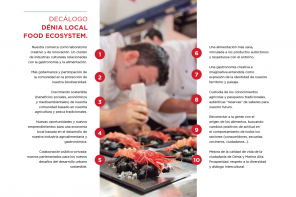La tradición gastronómica de Dénia y la Marina Alta se remonta a la Antigüedad. The gastronomical tradition of Dénia and the Marina Alta region dates back to antiquity.
Los fenicios introdujeron la vid y la elaboración del vino, pionera en la península ibérica. La pasa de la Marina se exportó desde el siglo XV a toda Europa y desde el XIX a América.
Las almadrabas y el garum de Dianium, la Dénia romana, prueban la larga tradición de salazones. Atún, melva, o pulpo seco se consumen en aceite de oliva o en guisos. De los productos frescos del mar destacan los erizos de mar, comidos en crudo, y la gamba roja elaborada a la manera local: hervida en agua de mar. De la Daniya musulmana proceden platos y métodos culinarios, procedimientos de cultivo y un amplio patrimonio agrario.
Las cocas de trigo están documentadas en 1627. Se siguen elaborando, como entonces, con salazones a los que se añadieron, a mediados del siglo XVIII, los tomates y pimientos americanos. De esta fusión surgen guisos como el tomacat o esgarrat. El arroz se impone en el siglo XVIII. Se elaboran arroces caldosos y melosos con verduras y hortalizas. Entre los arroces secos, muy variados, destaca el arroz a banda, a base de caldo de pescado, y que ya se servía en los banquetes de principios del siglo XX.
The Phoenicians introduced grapevines and winemaking, a ground-breaking activity in the Iberian Peninsula, with Dénia as the location for their first wine cellar. The raisins of the Marina Alta region were exported to the rest of Europe since the 15th century and to America since the 19th century.
The tunny fishing and garum of Dianium, the Roman Dénia, are evidence of the long tradition of preserving fish with salt. Dried tuna, mackerel, or octopus are eaten in olive oil or in stews. Amongst the fresh products from the sea are worth highlighting sea urchins, eaten raw, and the red prawn, as prepared by locals: boiled in seawater.
The Muslim Daniya has left us with culinary dishes and methods arising from cultivation and a broad, agricultural heritage. Documentation of wheat cocas (an Iberian flat bread) dates back to 1627. These continue to be prepared in the same way, with salted fish to which were added, in the middle of the 18th century, tomatoes and American bell peppers. This fusion results in «tomacat» or «esgarrat».
The use of rice begins during the 18th century. Both creamy and brothy rices are cooked with vegetables. Amongst the great variety of dry rices are noteworthy the «arroz a banda» made with fish stock, served during banquets in the early 20th century.





